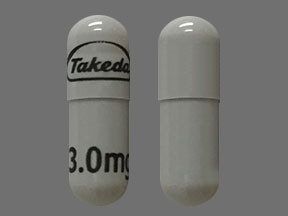Ninlaro Dosage
Generic name: ixazomib citrate 4mg
Dosage form: capsule
Drug class: Proteasome inhibitors
Medically reviewed by Drugs.com. Last updated on Aug 18, 2025.
Dosing and Administration Guidelines
NINLARO in combination with lenalidomide and dexamethasone
The recommended starting dose of NINLARO is 4 mg administered orally once a week on Days 1, 8, and 15 of a 28-day treatment cycle.
The recommended starting dose of lenalidomide is 25 mg administered daily on Days 1 through 21 of a 28-day treatment cycle.
The recommended starting dose of dexamethasone is 40 mg administered on Days 1, 8, 15, and 22 of a 28-day treatment cycle.
| 28-Day Cycle (a 4-week cycle) | ||||||||
|---|---|---|---|---|---|---|---|---|
| Week 1 | Week 2 | Week 3 | Week 4 | |||||
| Day 1 | Days 2-7 | Day 8 | Days 9-14 | Day 15 | Days 16-21 | Day 22 | Days 23-28 | |
| NINLARO | ✔ | ✔ | ✔ | |||||
| Lenalidomide | ✔ | ✔ Daily | ✔ | ✔ Daily | ✔ | ✔ Daily | ||
| Dexamethasone | ✔ | ✔ | ✔ | ✔ | ||||
For additional information regarding lenalidomide and dexamethasone, refer to their prescribing information.
NINLARO should be taken once a week on the same day and at approximately the same time for the first three weeks of a four week cycle. The importance of carefully following all dosage instructions should be discussed with patients starting treatment. Instruct patients to take the recommended dosage as directed, because overdosage has led to deaths.
NINLARO should be taken at least one hour before or at least two hours after food. The whole capsule should be swallowed with water. The capsule should not be crushed, chewed or opened.
If a NINLARO dose is delayed or missed, the dose should be taken only if the next scheduled dose is ≥72 hours away. A missed dose should not be taken within 72 hours of the next scheduled dose. A double dose should not be taken to make up for the missed dose.
If vomiting occurs after taking a dose, the patient should not repeat the dose. The patient should resume dosing at the time of the next scheduled dose.
Prior to initiating a new cycle of therapy:
- Absolute neutrophil count should be at least 1,000/mm3
- Platelet count should be at least 75,000/mm3
- Non-hematologic toxicities should, at the healthcare provider's discretion, generally be recovered to patient's baseline condition or Grade 1 or lower
Treatment should be continued until disease progression or unacceptable toxicity.
Dosage Modification Guidelines
The NINLARO dose reduction steps are presented in Table 2 and the dosage modification guidelines are provided in Table 3.
|
|||
| Recommended starting dose* | First reduction to | Second reduction to | Discontinue |
| 4 mg | 3 mg | 2.3 mg | |
An alternating dose modification approach is recommended for NINLARO and lenalidomide for thrombocytopenia, neutropenia, and rash as described in Table 3. Refer to the lenalidomide prescribing information if dose reduction is needed for lenalidomide.
| Hematological Toxicities | Recommended Actions |
| Thrombocytopenia (Platelet Count) | |
| Platelet count less than 30,000/mm3 |
|
| Neutropenia (Absolute Neutrophil Count) | |
| Absolute neutrophil count less than 500/mm3 |
|
| Non-Hematological Toxicities | Recommended Actions |
| Rash | |
| Grade† 2 or 3 |
|
| Grade 4 | Discontinue treatment regimen. |
| Peripheral Neuropathy | |
| Grade 1 Peripheral Neuropathy with Pain or Grade 2 Peripheral Neuropathy |
|
| Grade 2 Peripheral Neuropathy with Pain or Grade 3 Peripheral Neuropathy |
|
| Grade 4 Peripheral Neuropathy | Discontinue treatment regimen. |
| Other Non-Hematological Toxicities | |
| Other Grade 3 or 4 Non-Hematological Toxicities |
|
Dosage in Patients with Hepatic Impairment
Reduce the starting dose of NINLARO to 3 mg in patients with moderate (total bilirubin greater than 1.5-3 × ULN) or severe (total bilirubin greater than 3 × ULN) hepatic impairment.
Dosage in Patients with Renal Impairment
Reduce the starting dose of NINLARO to 3 mg in patients with severe renal impairment (creatinine clearance less than 30 mL/min) or end-stage renal disease (ESRD) requiring dialysis. NINLARO is not dialyzable and therefore can be administered without regard to the timing of dialysis.
Refer to the lenalidomide prescribing information for dosing recommendations in patients with renal impairment.
Frequently asked questions
- What is Ninlaro used for?
- Ninlaro vs Velcade, which is better?
- How much does Ninlaro cost compared to other chemo drugs?
- Is Ninlaro (ixazomib) a chemotherapy drug? How does it work?
- Does Ninlaro cause shingles (herpes zoster)?
- How effective is Ninlaro (ixazomib)?
More about Ninlaro (ixazomib)
- Check interactions
- Compare alternatives
- Pricing & coupons
- Reviews (3)
- Drug images
- Side effects
- During pregnancy
- FDA approval history
- Drug class: proteasome inhibitors
- Breastfeeding
- En español
Patient resources
Professional resources
Related treatment guides
See also:
Further information
Always consult your healthcare provider to ensure the information displayed on this page applies to your personal circumstances.


